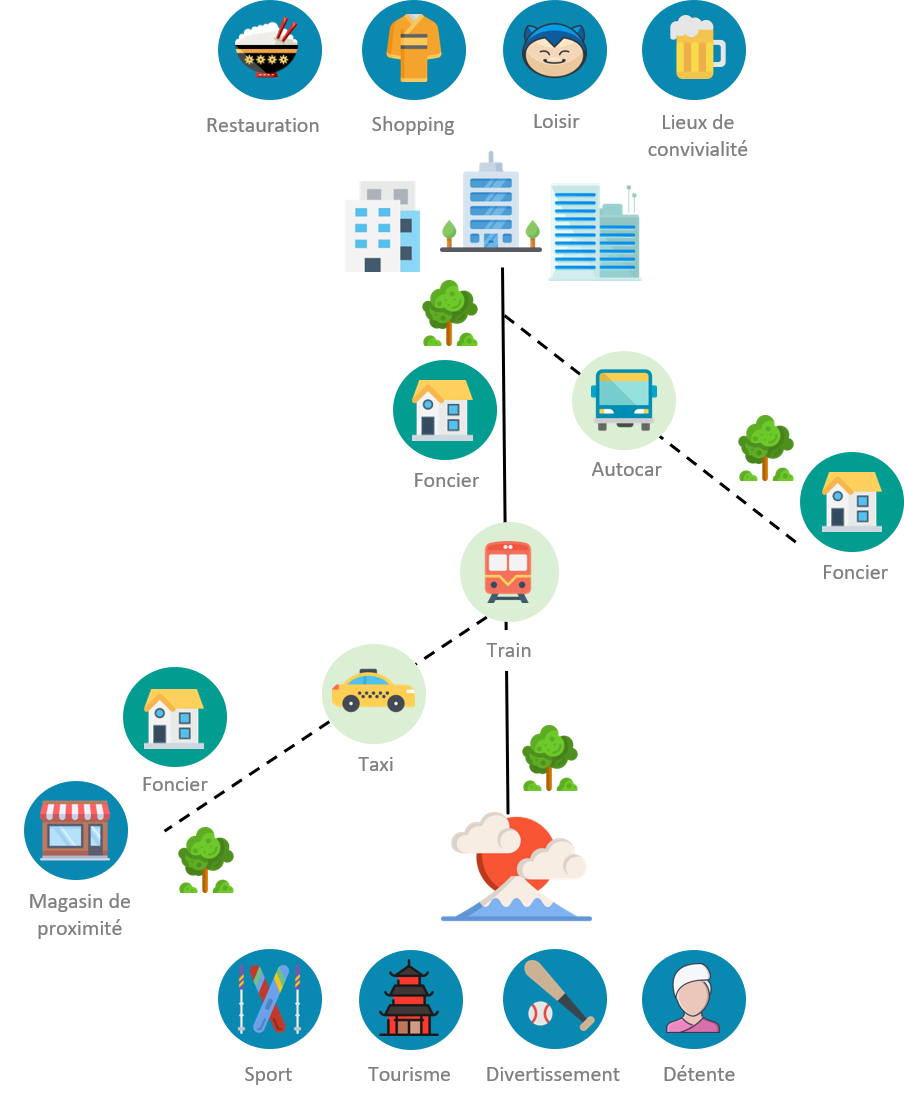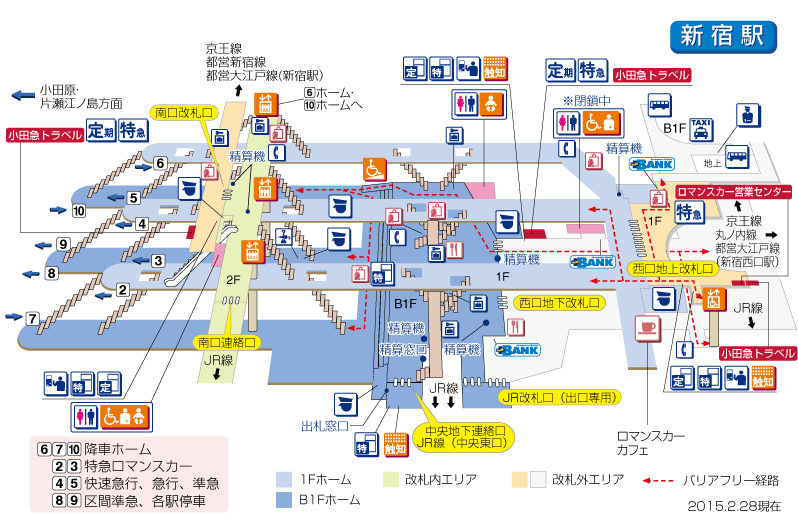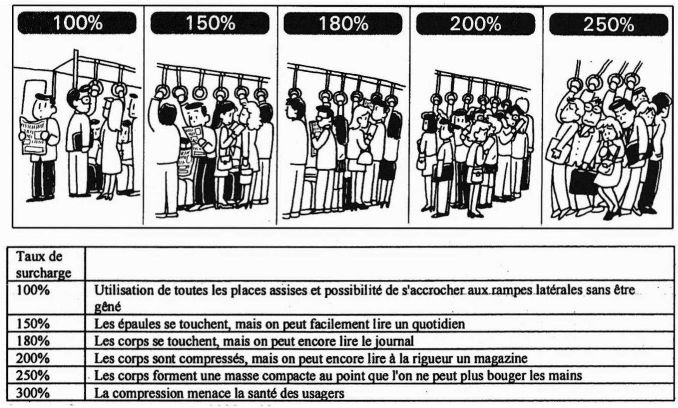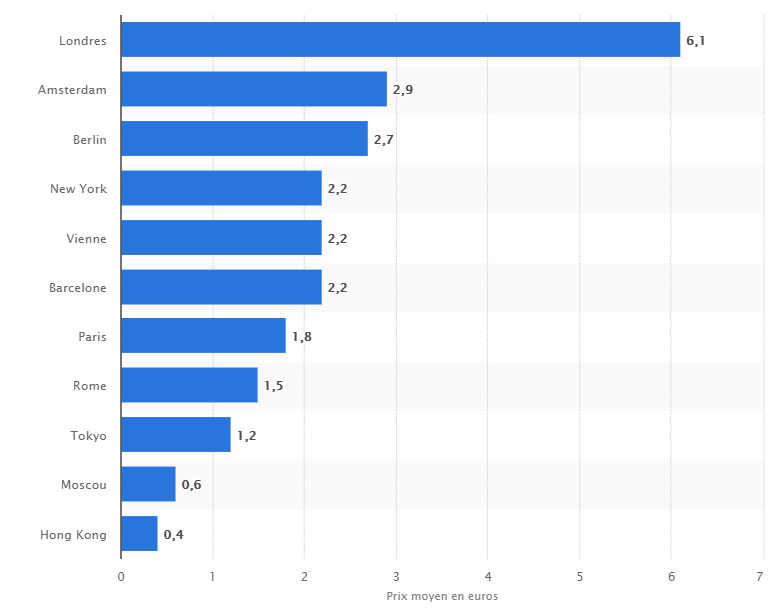Roland Barthes: ” The city I am talking about presents this precious paradox: it does have a center, but this center is empty” [i] . The center of Tokyo is empty because Tokyo revolves around its stations .
Tokyo, the railway city
The megalopolis of Tokyo has more than 37.7 million inhabitants, making it one of the largest conurbations in the world. Rail holds a predominant place there, with 57% of the region’s passenger traffic, passing through some 1,200 stations.
If the modal share of iron is particularly high there, in particular compared to other metropolises in the world, this is not, however, thanks to a particularly effective public policy of supply or promotion.

State protectionism to counter US auto imports has certainly played a role. This slowed down the development of the road network while the Japanese manufacturers strengthen their competitive advantage. As a result, iron has been able to develop in an environment relatively unconstrained by the private car and the road network today covers just under 8% of the territory in Tokyo, against around 20% in Paris and 16%. in London.
But to this is added the fact that the Japanese public authorities have shown since the Meji era a certain lack of interest in land use planning issues. Faced with this public deficiency, urban transport in Tokyo, as in other major Japanese metropolises, was implemented from the outset by private rail companies seeking profitability in a competitive market.
Private railway operators called ôtemintetsu in Japanese have become major players in urban development, particularly in the suburbs.
With the notable exception of the financing and management of the metro, even today, the public authorities are very liberal with regard to the management of mobility in Tokyo. While the central administration draws up master plans, these are not binding. They only give the authorities’ vision for the future of the urban rail network without constraining the private networks.
The ôtemintetsu “generalist private management” model
The ôtemintetsu have from the early 20 th century made of railway lines between Tokyo and its suburbs. Its areas were growing at the time, but the ôtemintetsu did not only respond to the growing demand for transport, they fueled it.
For this and in order to achieve economic profitability, the ôtemintetsu have gradually developed the concept of “generalist private management”, that is to say the combination of several activities:
- Transport as a unifying element. The ôtemintetsu created private rail infrastructure which was itself supplemented by complementary transport networks. To drive travelers from distant suburbs to stations and limit disruption of charges but also take advantage of the growth in motorization, they were the pioneers of door-to-door and invested in transport services by bus, taxi , coaches.
- Real estate : The ôtemintetsu have turned into real estate developers, speculating on the creation of value generated by the establishment of new stations. The subdivisions created on the model of the English garden cities were a real commercial success.
- Commercial and leisure activities : At the Tokyo end of the lines, they have built vast stations, moving from simple transit spaces to veritable “universes of services” [iii] offering travelers access to distribution, leisure, catering … At the other end of the line, in the suburbs, companies have brought out of the ground vast hotel complexes, thermal baths ( onsen), cabarets, baseball fields, etc. These new activities were intended to stimulate traffic in the opposite direction of the dominant home-work flows.

These non – rail activities – real estate, distribution, leisure, tourism – are still today real strategic axes for the fifteen ôtemintetsu which coexist. The most important have become sprawling structures bringing together a myriad of subsidiaries. This plurality of activities makes it possible to counterbalance the profitability of passenger transport activities, which is limited by the obligations in terms of services and the price ceilings imposed by the public authorities.
Consecration of the economic model, during the privatization of the national network of the Japan National Railways in 1987, the six regional companies which separated the network put into practice the model of “generalist management” and have also diversified.
Changes in the face of the city
This economic model has shaped the face of Tokyo and more broadly of Japan. In the ranking of the busiest stations in the world, the first 23 places are occupied by Japanese stations and the first three by Tokyo stations. Shinjuku triumphs at the top of this ranking. The Tokyo station exceeds 3.6 million daily travelers, or 1.2 billion per year. The quays of the six companies that operate there are linked by gigantic underground labyrinths dotted with stores of all kinds. It has no less than 200 entries and to find your way around, an application is entirely dedicated to it.

The stations have also become real magnets and an entire urban fabric made up of arcades, hotels and offices has developed around this string of railway lines.
Service excellence
The extreme complexity of the network or rather of the Tokyo networks does not prevent the excellence of the service. As such, we could say that the combination of competitive stimulation and land rent has made it possible to achieve an allocation of resources close to the optimum and an unparalleled quality of service. Trains in Tokyo can thus boast of their record punctuality to within five seconds in normal periods. They also offer great traffic safety and great comfort (air conditioning, cleanliness, passenger information, etc.).
Even the legendary rush hour overload of Japanese transport is not enough to stop this well-oiled mechanism.

Traveler information is an omnipresent concern there. Each station has its own musical identity, its eki melo, which makes it easy for travelers to know where they are. The platforms provide valuable information such as the distance to travel to reach your next train or the wagon to get on to facilitate your connection.
Since 2001, Tokyoites have also benefited from a unique ticketing medium, the Suica card, which can be used not only on the entire Greater Tokyo network regardless of the line taken, but also, and since 2013, in other cities in the archipelago such as Kyoto, Osaka, Nagoya or Fukuyama. Finally, the Suica can be used to pay at countless vending machines, as well as in many convenience stores and restaurants, but also on Amazon or on the Nintendo website.
A service that comes at a price … that remains reasonable
The excellence of this service comes at a cost, however. It requires significant resources. Travelers passing through Tokyo will be struck by the abundance of personnel deployed at the station. Each train departure gives birth to a real choreography in white gloves. In addition, there are the technical resources that are used. Trainsets and wagons are subject to scrupulous maintenance. For the customer, all this comes at a price, of course, but which remains moderate. While the prices of the high-speed train, the legendary Shinkansen, are soaring, the price of urban transport remains moderate as shown in the graph below.

An exacerbated urban sprawl
However, leaving urban planning in the sole hands of private companies also had damaging consequences on the physiognomy of the megalopolis. The search for profit has led the ôtemintetsu to go further and further , which has exacerbated urban sprawl and created dormitory towns with little public services, jobs or even green spaces. The pendular migrations, beneficial for the ôtemintetsu , have lengthened considerably.

The Tokyo mirror or the observatory of major European issues
Tokyo offers us to observe an uchronia, a parallel world in which the road network would have been less developed and where the public authorities would have declined its role of urban planner. It is clear that this world seems to have a certain head start compared to the major challenges of current urban mobility which today question France and Europe more broadly.
It offers a framework for reflection and inspiration on many crucial issues in determining the European transport of tomorrow: disruption of the classic schemes designed around a center – periphery relationship, roles and activities of private operators in passenger transport, articulation between mobility and development, social and economic importance of exchange hubs, addition of services around mobility, shift from competition between modes to intermodality, preponderance of marketing issues …
Marine Trillat

Source: AVELINE, Natacha. The City and Rail in Japan: The Expansion of Private Rail Groups in Tokyo and Osaka. New edition [online]. Paris: CNRS Éditions, 2003 Available on the Internet
[i] Roland Barthes, The Empire of Signs
[ii] https://www.japan-guide.com/e/e3011.html
[iii] Alain Bourdin (2000), “Le service à la Mobilité. Service chain security and service support services ”
[iv] Illustrations from www.flaticon.com :
Snorlax – Icon made by Roundicons Freebies from www.flaticon.com
Building / Train / House – Icon made by Vectors Market from www.flaticon.com
Pint / Baseball / Ski – Icon made by Smashicons from www.flaticon.com
Bus / Online store / Pagoda / Kimono / Tree / Mount Fuji – Icon made by Freepik from www.flaticon.com
Rice / Buildings- Icon made by Roundicons from www.flaticon.com
Office block – Icon made by Prosymbols from www.flaticon.com
Taxi / Woman – Icon made by Nikita Golubev from www.flaticon.com
Office – Icon made by Dimitry Miroliubov from www.flaticon.com
[v] https://www.shinjukustation.com/shinjuku-station-map-finding-your-way/
[vi] Ôtemintetsu no sugao 2000 cited by AVELINE, Natacha. The City and Rail in Japan: The Expansion of Private Rail Groups in Tokyo and Osaka.
[vii] https://fr.statista.com/statistiques/478362/prix-billet-de-transport-capitales/




